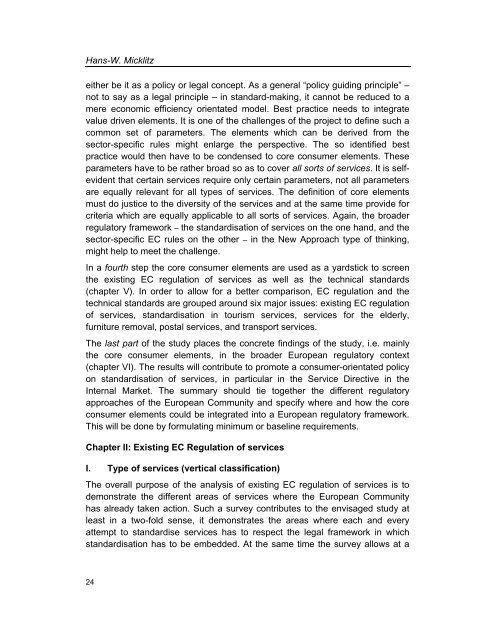Services Standards: Defining the Core Consumer Elements ... - ANEC
Services Standards: Defining the Core Consumer Elements ... - ANEC
Services Standards: Defining the Core Consumer Elements ... - ANEC
You also want an ePaper? Increase the reach of your titles
YUMPU automatically turns print PDFs into web optimized ePapers that Google loves.
Hans-W. Micklitz<br />
ei<strong>the</strong>r be it as a policy or legal concept. As a general “policy guiding principle” –<br />
not to say as a legal principle – in standard-making, it cannot be reduced to a<br />
mere economic efficiency orientated model. Best practice needs to integrate<br />
value driven elements. It is one of <strong>the</strong> challenges of <strong>the</strong> project to define such a<br />
common set of parameters. The elements which can be derived from <strong>the</strong><br />
sector-specific rules might enlarge <strong>the</strong> perspective. The so identified best<br />
practice would <strong>the</strong>n have to be condensed to core consumer elements. These<br />
parameters have to be ra<strong>the</strong>r broad so as to cover all sorts of services. It is selfevident<br />
that certain services require only certain parameters, not all parameters<br />
are equally relevant for all types of services. The definition of core elements<br />
must do justice to <strong>the</strong> diversity of <strong>the</strong> services and at <strong>the</strong> same time provide for<br />
criteria which are equally applicable to all sorts of services. Again, <strong>the</strong> broader<br />
regulatory framework – <strong>the</strong> standardisation of services on <strong>the</strong> one hand, and <strong>the</strong><br />
sector-specific EC rules on <strong>the</strong> o<strong>the</strong>r – in <strong>the</strong> New Approach type of thinking,<br />
might help to meet <strong>the</strong> challenge.<br />
In a fourth step <strong>the</strong> core consumer elements are used as a yardstick to screen<br />
<strong>the</strong> existing EC regulation of services as well as <strong>the</strong> technical standards<br />
(chapter V). In order to allow for a better comparison, EC regulation and <strong>the</strong><br />
technical standards are grouped around six major issues: existing EC regulation<br />
of services, standardisation in tourism services, services for <strong>the</strong> elderly,<br />
furniture removal, postal services, and transport services.<br />
The last part of <strong>the</strong> study places <strong>the</strong> concrete findings of <strong>the</strong> study, i.e. mainly<br />
<strong>the</strong> core consumer elements, in <strong>the</strong> broader European regulatory context<br />
(chapter VI). The results will contribute to promote a consumer-orientated policy<br />
on standardisation of services, in particular in <strong>the</strong> Service Directive in <strong>the</strong><br />
Internal Market. The summary should tie toge<strong>the</strong>r <strong>the</strong> different regulatory<br />
approaches of <strong>the</strong> European Community and specify where and how <strong>the</strong> core<br />
consumer elements could be integrated into a European regulatory framework.<br />
This will be done by formulating minimum or baseline requirements.<br />
Chapter II: Existing EC Regulation of services<br />
I. Type of services (vertical classification)<br />
The overall purpose of <strong>the</strong> analysis of existing EC regulation of services is to<br />
demonstrate <strong>the</strong> different areas of services where <strong>the</strong> European Community<br />
has already taken action. Such a survey contributes to <strong>the</strong> envisaged study at<br />
least in a two-fold sense, it demonstrates <strong>the</strong> areas where each and every<br />
attempt to standardise services has to respect <strong>the</strong> legal framework in which<br />
standardisation has to be embedded. At <strong>the</strong> same time <strong>the</strong> survey allows at a<br />
24
















